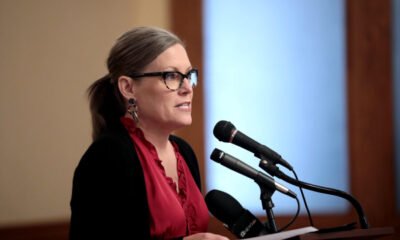ag-urban
Water Bill Aims to Transform Agricultural Lands into Housing Developments

Correction: A previous version of this story left a digit off of the number of acres of irrigated farmland in the Phoenix, Pinal and Pima Active Management Areas that could use the ag-to-urban program. It has been corrected to 425,232 acres.
Sen. T.J. Shope, a Republican from Coolidge, is set to reintroduce a bill aimed at creating a pathway for farmers to sell agricultural land to developers. This initiative seeks to tackle the pressing housing shortage while also addressing groundwater conservation in the state.
The proposed “ag-to-urban” legislation targets areas with restricted home construction, highlighting the benefits of single-family homes, which typically consume less water compared to agricultural lands. Shope’s bill is a response to past legislative efforts that faced challenges; a similar bill was rejected by Gov. Katie Hobbs last year. While the Governor acknowledged the bill’s intent, she pointed out that the data did not support a one-size-fits-all approach during her veto.
If successful this time, Shope believes the bill could significantly increase Arizona’s housing supply. Current estimates suggest there are 425,232 acres of irrigated farmland available for potential development. According to Republican Senate staff, converting half of this land could yield over a million new homes, as new developments generally average about five homes per acre.
To build consensus, Shope has initiated stakeholder meetings involving various parties, including lawmakers, the Governor’s Office, and water resource agencies, alongside local communities. Input from experts in water policy indicates that the program’s effectiveness will hinge on its ability to safeguard aquifers while facilitating development.
Sarah Porter, director of the Kyl Center for Water Policy at Arizona State University, noted that agriculture is a significant contributor to water depletion. Transitioning water use from agriculture to lower-demand residential uses presents a promising opportunity. Yet, without proper safeguards, there’s a risk that such developments might not preserve long-term water supplies.
The Kyl Center recently published a report that connects the limitations on new housing due to water supply concerns with rising home prices. It emphasized that housing affordability is influenced by various factors, including zoning laws and local planning decisions.
Porter stressed the importance of individual housing solutions beyond just single-family homes. Meanwhile, Shope cited advancements in agricultural science as evidence that less farmland is necessary to achieve comparable yields. These technologies have allowed the state to maintain water usage levels akin to those of the 1950s, even as the population has skyrocketed from one million to over seven million.
Examples from Chandler and Gilbert demonstrate the potential for successful transitions from agricultural land to residential communities. Shope noted a significant drop in water usage in these transformed areas, which could serve as a model for future developments.
However, Porter cautioned that while residential water demands may be lower, they could still escalate depending on the restrictions placed on water pumping for new developments. She underscored the need for thoughtful policy to prevent excessive depletion of water resources.
Shope believes that if the Legislature backs this bill, it could become a landmark piece of legislation under consideration by the Governor. He expressed optimism about its potential impact on water management and housing availability in Arizona.
“I do think it’s going to be the most consequential water bill that has a chance of passing,” he assured. “The significance of this proposal far outweighs other initiatives currently being discussed.”

















